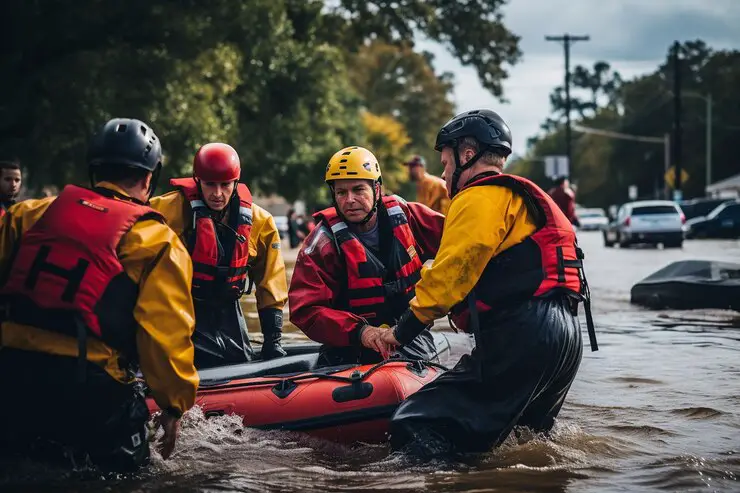The Vital Role of Emergency Response Teams on Safeguarding Communities in Crisis Management

In moments of crisis and disaster, the swift and coordinated response of emergency services can mean the difference between chaos and control, life and death. At the forefront of this response are Emergency Response Teams (ERTs), highly trained groups of individuals dedicated to mitigating the impact of emergencies and ensuring the safety and well-being of communities. The ability to swiftly and effectively respond can mean the difference between life and death. Emergency response teams (ERTs) are at the forefront of these efforts, playing a critical role in mitigating risks, providing assistance, and restoring order in times of crisis. This article explores the essential functions, training, and significance of Emergency Response Teams in safeguarding communities during times of crisis.


Page Contents
- 1 The Vital Role of Emergency Response Teams on Safeguarding Communities in Crisis Management
- 2 Key Functions of Emergency Response Teams
- 3 The duration and specific courses required for continuing education for an emergency response team can vary based on the organization, jurisdiction, and the specific roles within the team.
- 4 Here is the 5 general outline:
- 5 Conclusion
The Vital Role of Emergency Response Teams on Safeguarding Communities in Crisis Management
The Essence of Emergency Response Teams

Emergency Response Teams, also known as ERTs, are specialized groups of professionals, serve as the backbone of crisis management systems and volunteers equipped to respond to a wide range of emergencies, including natural disasters, industrial accidents, public health crises, and acts of terrorism. Comprising individuals with diverse skill sets and expertise, ERTs are organized, trained, and ready to deploy at a moment’s notice to address evolving threats and challenges.


Key Functions of Emergency Response Teams

- Rapid Deployment: When an emergency occurs, time is of the essence. Emergency response teams are trained to mobilize quickly and efficiently, deploying resources to the affected area within minutes to assess the situation and initiate response efforts.
- Risk Assessment and Management: ERTs conduct thorough risk assessments to evaluate the scope and severity of the emergency. They identify potential hazards, assess the level of risk to individuals and property, and develop strategies to mitigate risks and ensure the safety of responders and the public.
- Search and Rescue Operations: In situations involving trapped or injured individuals, ERTs coordinate search and rescue operations to locate and extract survivors. Whether it’s navigating through debris in the aftermath of a natural disaster or responding to a building collapse, these teams utilize specialized equipment and techniques to reach and evacuate victims safely.
- Medical Assistance: ERTs provide critical medical assistance to those in need, administering first aid, stabilizing injuries, and transporting patients to medical facilities for further treatment. Paramedics and emergency medical technicians (EMTs) play a crucial role in triaging patients, prioritizing care, and ensuring that individuals receive timely and appropriate medical attention.
- Fire Suppression and Hazard Control: Firefighters are an integral part of emergency response teams, responsible for suppressing fires, preventing their spread, and mitigating associated hazards. Equipped with specialized firefighting equipment and protective gear, these professionals work tirelessly to contain fires and protect lives and property from destruction.
- Public Safety and Security: Law enforcement officers are tasked with maintaining public safety and security during emergencies, enforcing evacuation orders, managing traffic flow, and preventing looting or other criminal activities. Their presence helps maintain order and ensure that response efforts proceed smoothly in challenging circumstances.
- Incident Command: ERTs establish command structures and incident management systems to ensure efficient coordination and communication among responders. Incident commanders oversee operations, allocate resources, and make critical decisions to address evolving circumstances and priorities.

Collaboration and Coordination
Effective emergency response requires seamless collaboration and coordination among various stakeholders, including government agencies, non-governmental organizations (NGOs), and private sector entities. Emergency response teams work closely with these partners to share information, allocate resources, and coordinate response efforts, ensuring a unified and comprehensive approach to crisis management.
Training and Preparedness
Preparation is key to effective emergency response. ERT members undergo rigorous training and exercises to hone their skills, familiarize themselves with protocols and procedures, and simulate real-life scenarios. This training encompasses a wide range of topics, including disaster response, incident command, hazardous materials handling, and emergency medical care, among others.
The duration and specific courses required for continuing education for an emergency response team can vary based on the organization, jurisdiction, and the specific roles within the team.
Here is the 5 general outline:
- Duration: Continuing education for emergency response teams typically involves ongoing training throughout the year, often in the form of regular sessions, workshops, and exercises. The duration can vary from a few hours to several days depending on the topics covered and the level of certification required.
- Courses Required: Here are some common courses that may be required for continuing education:a. First Aid/CPR: Regular refreshers in first aid and cardiopulmonary resuscitation (CPR) are often essential for emergency response teams.b. Emergency Medical Technician (EMT) Training: Depending on the level of medical care provided by the team, members may need to undergo EMT training and maintain certification.c. Disaster Preparedness and Response: Courses covering disaster preparedness, incident command systems (ICS), and response protocols are crucial for effective emergency response.d. Hazardous Materials Handling: Training in handling hazardous materials and substances may be necessary for teams dealing with incidents involving chemical, biological, radiological, nuclear, and explosive (CBRNE) threats.e. Technical Rescue Training: For teams involved in technical rescue operations such as swift water rescue, confined space rescue, or urban search and rescue (USAR), specialized training is essential.f. Firefighting Techniques: Some emergency response teams, particularly those in fire departments or volunteer fire companies, may require training in firefighting techniques and fire behavior.g. Communications: Training in radio communication procedures and technologies is vital for maintaining effective communication during emergencies.h. Psychological First Aid: Providing psychological support to survivors and team members during and after emergencies is increasingly recognized as essential training for emergency responders.i. Legal and Ethical Considerations: Understanding legal and ethical considerations in emergency response, including patient confidentiality and liability issues, is important for all team members.
- Specialized Training: Depending on the specific responsibilities of the team, additional specialized training may be required. This could include training in weapons of mass destruction (WMD) response, tactical operations, disaster recovery, or specific skills related to the team’s area of expertise.
- Continuous Evaluation: Beyond formal courses, ongoing evaluation and skill maintenance are crucial. Regular drills, simulations, and debriefings help ensure that team members remain proficient and up-to-date with the latest protocols and best practices.
- Certification Maintenance: Many certifications require periodic renewal through continuing education credits or re-examination. It’s important for team members to stay informed about the renewal requirements for their certifications and to fulfill them in a timely manner.
This list provides a broad overview, but the specific requirements for continuing education will depend on the nature of the emergency response team and the regulations governing emergency response in their jurisdiction.
Conclusion
Emergency response teams are the unsung heroes of crisis management, working tirelessly behind the scenes to safeguard lives, property, and communities. Their dedication, professionalism, and bravery in the face of adversity exemplify the best of human resilience and compassion. As we navigate an increasingly complex and unpredictable world, the importance of well-trained and well-equipped emergency response teams cannot be overstated. By investing in preparedness, collaboration, and continuous improvement, we can ensure that these teams remain ready and capable to respond to any emergency, whenever and wherever it may occur.







